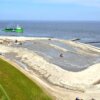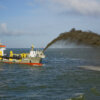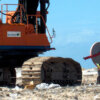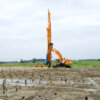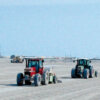Dredging techniques cover a wide range of activities and for each project an analysis must be made to determine which technique is appropriate and feasible.
The techniques that the dredging industry have developed to execute projects are specific to the type of project. They deal both with how dredging is executed and also how fill is treated to make it suitable for use, as well as how sediments are placed at the dredging site.
Compaction
Compaction is used to increase the density of fill and improve properties such as compressibility, shear resistance and resistance against liquefaction.
Dynamic compaction
Dynamic compaction is a technique used for in-situ densification of granular soil deposits by heavy impact.
Explosive Compaction
Explosive Compaction involves placing a charge at depth in a borehole in loose soil and then detonating the charge.
Ground Improvement
Ground improvement techniques are used when the behaviour of the fill mass and/or the underlying soil does not meet required design criteria.
Hydraulic Fill
Hydraulic fill is material that is dredged from a borrow area or a other area and placed at a site to raise the level of the land or build new land.
Land reclamation
Land reclamation is the process of creating new land by raising the elevation of a waterbed or low-lying land or by pumping water out of muddy morass areas.
Rock Fill
Rock is often encountered during capital dredging projects and this dredged rock can become high quality fill when used within specific guidelines.
Rainbowing
Rainbowing is a method by which trailing suction hopper dredgers place material in shallow areas by pumping into the air through a hose with a nozzle.
Soil Improvement
Soil improvement is applied to both consolidate existing loose subsoils and sometimes specifically for compaction of newly reclaimed soil.
Subsea rock installation
Subsea rock installation is a technique used for rock placement to protect marine infrastructure, especially for offshore oil, gas and wind energy projects.
Underwater Placement in Bulk of Fill Material
Underwater placement of fill is usually performed by trailing suction hopper dredgers and barges by opening their bottom doors or by split hull vessels.
Vertical or Wick Drains
Prefabricated vertical drains or Wick drains are applied in areas where loose, compressible, water-saturated soils make the soil unstable.
Vibratory surface compaction
Vibratory surface compaction is a method used on the surface of a reclamation area to increase the density, shear strength, and stiffness of the fill.
related
Articles
The Fehmarnbelt tunnel trench dredging project

A fixed and direct transport connection between Scandinavia and Central Europe has been an enduring vision for many decades. This vision is about to be realised with the construction of the Fehmarnbelt Fixed Link, an 18-kilometre-long immersed tunnel between Rødbyhavn in Denmark and Puttgarden in Germany. When it opens in 2029, the tunnel will be the longest immersed tunnel in the world combining a dual railway and motorway connection. This article provides insight into the improved dredging equipment used and the methodology specially adapted and further developed to the project’s requirements.






